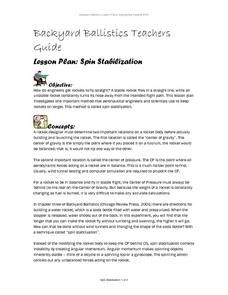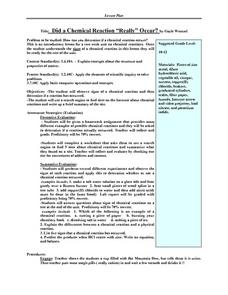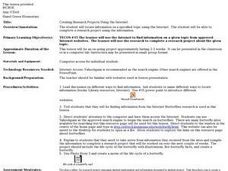Curated OER
Information Technology
Students identify various threats to computers today. In this technology lesson, students explore various techniques to address security issues. They demonstrate what they have learned using classroom computers.
Curated OER
The Nesting Habits of Folders
Students create an organized web of nested grade level folers. Within each grade level folder, they create a Language Arts/Social Studies folder and a Math/Science folder. All folders be color coded.
Curated OER
Where Do Animals Come From?
Students use library search engines to research an animal and its origin. In this animal research lesson, students research their assigned animal using ProQuest. Students then find the country of origin of the animal using a library...
Curated OER
Water Lesson Plan
Pupils discuss the importance of water in our daily lives. In this physics lesson, students calculate the pressure of water tower systems. They investigate the effect of certain variables using a computer simulation.
Curated OER
How Animals Meet Their Needs
Fourth graders research the Internet for facts relating to the animal of their choice. They use information from their Internet search to complete their animal project. TLW use his or her own words when writing their report.
Curated OER
Scientific Scenes
Students discover how the public's perceptions of science have changed throughout recent history; then research scientific and technological breakthroughs in a variety of areas. They then create plays that allow scientists to encounter...
Curated OER
Spin Stabilization
Learners investigate methods used by aeronautical engineers to keep rockets on target. After exploring the center of gravity and the center of pressure, students build water rockets. Learners use various methods to design fins on the...
Curated OER
Did a Chemical Reaction "Really" Occur?
Students perform several different experiments to observe signs of chemical reactions and determine if reaction has occurred, use search engine to find Internet sites pertaining to chemical reactions, and write up brief summary of site.
Curated OER
Creating Research Projects Using the Internet
Students discuss methods of locating information on the internet. They visit a specific website about butterflies and explore its homepage and web links. As students examine the site, they take notes and organize information for a...
Curated OER
Exploring Today's Technology
Second graders explore technology. In this science instructional activity, 2nd graders discuss various forms of technology. Students research technology that they use everyday and write a sentence about each one of the technologies.
Curated OER
Sextant Solutions
Middle schoolers explore ways a sextant can be a reliable tool that is still being used by today's navigators and how computers can help assure accuracy when measuring angles. This activity will show how computers can be used to...
Curated OER
Breaking News English: Computers to Match Man by 2009
In this English worksheet, learners read "Computers to Match Man by 2009," and then respond to 47 fill in the blank, 7 short answer, 20 matching, and 8 true or false questions about the selection.
Curated OER
Preparation for Engineering Careers
Students explore all the careers that deal with math, science, technology and engineering. They assess the importance of clearly explaing yourself in writing, making public presentations and utilizing technical jargon in dealing with...
Curated OER
The Changing Face of Science
Students are introduced to the ways women have changed the fields of Science and Math. Using the internet, they research women's contributions to these two fields and take notes on the information they find. They organize their data...
Curated OER
Moment of Inertia Contest
Students design a wheel that can go down the ramp with the smallest moment of inertia. In this technology instructional activity, students construct their model using a computer program. They calculate the moment of inertia of their...
Teach Engineering
Biomes and Population Dynamics - Balance Within Natural Systems
How large can a population become? The fifth installment of a nine-part unit teaches young ecologists about limiting factors that determine the carrying capacity of species in the Sonoran Desert. Here is a PowerPoint to help present this...
Teach Engineering
Swinging Pendulum
Get into the swing of things. Pupils use a pendulum to demonstrate the conversion of potential energy to kinetic energy and back. After measuring the speed of a pendulum and compare it to the calculated theoretical speed, they determine...
PHET
Planet Designer: Kelvin Climb
It's time to get those creative juices flowing! This second instructional activity in a series of five continues allowing pupils to design their own planets. It the same format as the first, but, this time, allows students to alter...
Teach Engineering
Acoustic Mirrors
Investigate sound waves with acoustic mirrors. Using audio software, groups make recordings of musical instruments, both with and without acoustic mirrors. They compare the recordings to see the effect of acoustic mirrors on sound waves.
National Nanotechnology Infrastructure Network
Hiding Behind the Mask
Microchips are a man-made wonder. Investigate the manufacturing wonder with a hands-on inquiry-based lesson. Scholars simulate the process of pattern transfer using photoresist. Their conclusion identifies how their process replicates...
Lawrence Hall of Science
Photolithography
Examine the use of photolithography in the fabrication of circuit boards and other components. An advanced activity teaches pupils a process for transferring a pattern onto a surface. Using UV light and a light reactive substance,...
Chicago Botanic Garden
Calculating Your Carbon Footprint
Unplugging from technology for one day per week will decrease your carbon footprint—are you up to the challenge? Part two in a series of three allows individuals to explore their personal carbon footprints. By first taking a quiz at home...
LABScI
Kinematics: The Gravity Lab
Falling objects can be brutal if you don't protect your noodle! Scholars explore the motion of falling objects through measuring short intervals to determine if the distance traveled varies with time. Building off of this, scholars...
Cornell University
The Physics of Bridges
Stability is key when building a bridge. Scholars explore the forces acting upon bridges through an analysis of Newton's Laws and Hooke's Law. The activity asks individuals to apply their learning by building a bridge of their own.

























